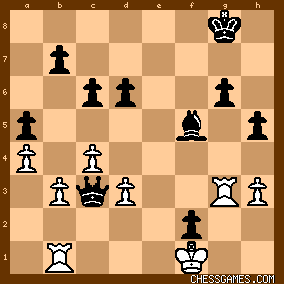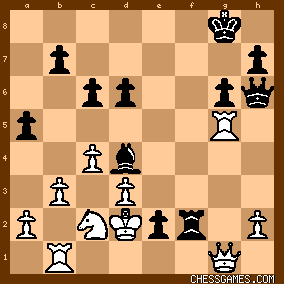|
< Earlier Kibitzing · PAGE 3 OF 3 ·
Later Kibitzing> |
| Oct-04-08 | | jonyfin: I believe that the quiet Qh3 deserves some attention as well |
|
| Oct-04-08 | | kevin86: I have a slightly different conclusion,but I think it has a flaw :( 32...♕f6+ 33 ♔e2 ♗g4+ 34 ♖xg4 ♕f2+ 35 ♔d1 ♕f1#-but it isn't as ♘e1 is possible |
|
| Oct-04-08 | | kirchhoff: <Antonius Blok:> After 31... Bxg4, white can play Nxd4 and Black's attack fails. |
|
| Oct-04-08 | | kirchhoff: <jonyfin:> Qh3 is interesting. It appears to force either Ne1 or Qf1 in response. In either case Black can continue to apply pressure and should win, but the continuation isn't clear. |
|
| Oct-04-08 | | Antonius Blok: <kevin86> The weakness of yout line is that on 33... Bg4+ white have the choice, they can let the bishop and simply move their king: 33.Ke1 Qh4+ 34.Rg3
Notice that in the line of Smejkal, they haven't this choice, they're forced to take the bishop ! |
|
| Oct-04-08 | | johnlspouge: Saturday (Very Difficult)
J M Bellon Lopez vs Smejkal, 1970 (31…?) Black to play and win.
Material: 2Bs for R+N. The White Ke2 in the center has 2 legal moves. The two escape squares are light, suggesting that Black should prioritize the activation of Bd7. Currently, the Black Bd4 and Pe3 bind the White pieces with control of the dark squares, but the White Nc2 is challenging them. The Black Rf8 attacks the weak Pf3. The Qh4 has an entry point at f2, covered by Rg2, suggesting a deflection combination. Candidates (31…): Rxf3
31…Rxf3 (threatening 32…Rf2+ 33.Rxf2 Qxf2+ 34.Kd1 Bxg4#) Flight is not an option [32.Kd1 Rf1+]. White can counterattack in one of two ways: (1) 32.Nxd4 Rf2+ (threatening 33...Rxg2)
33.Rxf2 [else, the White Ke2 is in a serious mating net having lost all material compensation] 33…Qxf2+ 34.Kd1 Bxg4+ 35.Ne2 [Nf3 Bxf3#] Qxe2#
(2) 32.Kxf3 Bxg4+
Black will be mated.
(2.1) 33.Kf4 [or Ke4] Be2+ 34.Rg4 Qxg4#
(2.2) 33.Rxg4 Qf2+ 34.Ke4 Qf5+ 35.Kxd4 Qe5#
White can reinforce the present defensive line:
(3) 31.Qg1 Rf2+ 32.Rxf2 [Ke1 Rxg2+] [Kd1 Rxg2 33.Qxg2 Bxg4+] 32…exf2 33.Qf1 [Qd1 Bxg4+] Bxg4+ 34.Kd2 Qg5+ 35.Nd3 Qxd3+ 36.Kc2 Be2 Faced with the threat to Qf1 and the mate threats, White can resign. (4) 31.Qe1 Rf2+ 32.Kd1 [Rxf2 is similar to Variation (3)] 32…e2+ 33.Kd2 [Kc1 Rf1] Qg4+ 34.Nd3 Qxd3+ 35.Kc2 Rxg2 White has nothing to play for. |
|
| Oct-04-08 | | Antonius Blok: <kirchhoff> You're right! But, isn't the same if we play Nxd4 after Rxf3 ? |
|
| Oct-04-08 | | Woody Wood Pusher: 31..Rxf3 was the first move I considered and although the mating line starting 32.Kxf3 was easy (I did not expect this to be the line played) the sub-variations are quite complex. I did not see 32.Qg1 but checked all other defenses, this also fails to save white according to the computer. e.g. 31..Rxf3 32.Qg1,Rf2+ 33.Rxf2,exf2 34.Qg2,Bxg4+ 35.Kf1, Bh3 36.Nxd4,Bxg2+ 37.Kxg2, Qxd4 - + |
|
Oct-04-08
 | | al wazir: <Once: . . . as usual> Thanks, but I'm afraid your stats are in error. My won/lost record is comparable with the Washington Nationals'. |
|
| Oct-04-08 | | johnlspouge: Toga II 1.3.1 evaluates best play as follows. Humans can improve near the end of the full computer variation given. [ply 15/66 time 06:29 value (to White) -6.82]
31...Rxf3 32.Qg1 Bxg4 33.Rxg4 Rf2+ 34.Kd1 e2+ 35.Kd2 Qh6+ 36.Rg5 e1Q+ 37.Kxe1 Rxc2 38.Qg3 Bf2+ 39.Qxf2 Rxf2 40.Kxf2 Qxg5 41.Re1 Qf4+ 42.Kg1 Qd4+ 43.Kg2 Qxd3 44.Re7 Qd2+ 45.Kf3 Qxa2 46.Rxb7 Qxh2 Other suggested candidates, 31...Bxg4 and 31...Qh3, permit White to draw: [ply 15/51 time 00:56 value (to White) -0.35]
31...<Bxg4> 32.Nxd4 Bh3 33.Qxe3 Bxg2 34.Qe6+ Rf7 35.Qxd6 Bh3 36.Qb8+ Rf8 37.Qe5 Rd8 38.Nc2 Bd7 39.Qg3 Qf6 40.Ne3 Bf5 41.Nxf5 Qxf5 42.f4 Re8+ 43.Kf1 [ply 15/36 time 00:19 value (to White) -0.09]
31...<Qh3> 32.Qf1 c5 33.Rg3 Qxh2+ 34.Qg2 Qh4 35.Rh1 Qe7 36.Rgh3 Rf7 37.Qg3 Bc3 38.Nxe3 Bd4 39.Qg1 Bc6 < <dzechiel> wrote: [snip] The first move practically has to be [snip] 31...Rxf3 [snip] I only chose 31...Rxf3 after convincing myself that other moves proved insufficient.> I did not bother to look at any other move. After nearly a year of CG puzzles, it appears I have turned into bloodthirsty maniac :) < <JG27Pyth>, please insert Dr Jekyll and Mr Hyde joke here :) > Because I set myself the standard of verifying a "solution" by enumerating variations, immediate choice of the correct candidate is very valuable to me. Wrong candidates exact a painful penalty with worthless, lengthy, losing variations. Beyond the preliminary observations in my first post today, there are at least two other indications that 31...Rxf3 is the correct candidate: (1) the only defender on White's K-side (Rg2) ends up alone facing Q+2B+Pe3 after 31...Rxf3; (2) the dark-square bind screams for Black to break the White P-chain on the complementary light squares; and (3) as <al wazir> points out, the only defense for the base Pf3 of White's P-chain is Ke2. (Never send the boss in to do a real job! :) The move 31...Bxg4 is not as good as 31...Rxf3 because: (1) Pf3 is the base of the P-chain, not Pg4; and (2) on recapture, 31...Rxf3 decoys the K out into the open, 31...Bxg4 does not. (A position where the heavy pieces control a rank behind the K can be worth as much as two minor pieces. Today's position was easy by comparison, because the mate could be calculated explicitly.) |
|
| Oct-04-08 | | jovack: I thought white would take the bishop with knight on 32.
King taking rook makes the puzzle easier. |
|
| Oct-04-08 | | johnlspouge: < <al wazir> wrote: [snip] My won/lost record is comparable with the Washington Nationals'.> This week in our illustrious little burg of Wash, DC, the free weekly "City Paper" has as its cover article "The Collapse of the Nationals Market". Inside is the byline: "When are Nats tickets like bad mortgages? When you can't unload them, even for free." Cheer up, <al>. Things aren't that bad for you, yet :) |
|
| Oct-04-08 | | kirchhoff: <Antonius Blok:> No, because now the rook has broken through and can move to f2, out of reach of the Knight. <johnlspouge: >, as well as the others, discuss this in some detail. |
|
| Oct-04-08 | | Underworld: This was a fun one for me. Taking with the rook was my favorite line and I fought back a little harder with white than Lopez did, and it is obvious that its just prolonging the death of the white king. The is no way for white to get out of the net once he is on the 3rd row. |
|
| Oct-04-08 | | whiteshark: pretty neigh |
|
Oct-04-08
 | | pittpanther: I am 6/6 this week - which rarely happens. But alas, Sunday is always tough! I think Friday and Saturday were easier than in most weeks (or perhaps I am getting better - but I think the former is more likely.) |
|
| Oct-04-08 | | Andrijadj: Too easy for a saturday puzzle...Yes,you do need to calculate a lot but the moves(Rf3 and Bg4)are too obvious...To quote Kasparov,you first play such a move and then calculate... |
|
| Oct-04-08 | | agb2002: White is an exchange up but his king and pieces are very poorly placed. A) 31... Rxf3
A.1) 32.Kxf3 Bxg4+
A.2.a) 33.Ke4(or f4) Be2+ 34.Rg4 Qxg4 mate.
A.2.b) 33.Rxg4 Qf2+ 34.Ke4 Qf5 35.Kxd4 Qe5 mate.
A.2) 32.Nxd4 Rf2+
A.2.a) 33.Rxf2 Qxf2+ 34.Kd1 Bxg4+ and mate next move. A.2.b) 33.Kxe3 Rxg2 and white's king side will disappear and, if his king is not mated before, black's passed pawns will win. A.2.c) 33.Kd1 Rxg2 34.Qxe3 Qxh2 threatening Bxg4+ and Rg1+. A.3) 32.Rg3 Rf2+ 33.Kd1 Qxh2 threatening Rd2+ and Qxg3. A.4) 32.Ne1 Rf2+ 33.Kd1 Bxg4+ 34.Rxg4 Qxg4+ winning.
A.5) 32.Qg1 Rf2+
A.5.a) 33.Kd1 e2+ 34.Kc1 Qg5+ winning.
A.5.b) 33.Rxf2 exf2 34.Qg3 Bxg4+ 35.Kf1 Bh3+ 36.Ke2 is not clear to me. Perhaps I'd try an endgame with B against N with a pawn up after trading queens and recovering the exchange with f1=Q. B) 31... Bxg4
B.1) 32.Rxg4 Qf2+ 34.Kd1 e2+ 35.Kd2 e1=Q mate.
B.2) 32.fxg4 Rf2+ 34.Kd1 e2+ 35.Kd2 e1=Q+ 36.Kxe1 Rxg2+ 37.Kd1 Qxg4+ 38.Ke1 Qe2 mate. B.3) 32.Nxd4 and things look worse.
I'd go for line A). Time to post and check.
|
|
| Oct-04-08 | | agb2002: I'm reasonably satisfied because I found the possible answer Qg1 :) but not the best reply against it :(. Anyway, I learnt the lesson from yesterday: the queen can deliver mate with the only help of pawns. |
|
| Oct-04-08 | | sbot: Hello, chessgames - The final position is check mate, not check! |
|
| Oct-04-08 | | DarthStapler: I got the first three moves |
|
| Oct-04-08 | | PositionalTactician: Can you believe it? I found all the variations! |
|
| Oct-04-08 | | mikejaqua: I found the first move, then was able to find each move thereafter as I went along. I could not see the whole thing from the starting position though. |
|
| Oct-05-08 | | zenpharaohs: 32 Kxf3?? is a blunder. The best response is probable 32 Qg1. However white is still mortally wounded. According to Rybka: 32 Qg1 Bxg4
then either
33 Nxd4 Rg3+
34 Kf1 Qf6+
35 Qf2 exf2
36 Rxg3 Qxd4
37 a3 h5
38 a4 Qc3
39 h3 Bf5

click for larger viewa painful zugzwang
40 Kxf2 h4
black doesn't even need to pick up the rook
41 Re3 Qc2+
no more Mr. Nice guy.
The other line is,
33 Rxg4 Rf2+
34 Kd1 e2+
35 Kd2 Qh6+
36 Rg5
Now how often do you see a position where promotion is important, but it doesn't matter at all which piece is chosen? 
click for larger view36 ... e1(QRBN)+
37 Kxe1 Rxc2
38 Qg3 Bf2+! ouch
39 Qxf2 Rxf2
40 Kxf2 Qxg5
and white is simply down by queen and pawn to rook, and he's going to lose more too. It's interesting that white gets to choose between a straight jacket and a stick of dynamite, but it doesn't afford him any hope either way. |
|
| Oct-24-08 | | patzer2: With the demolition decoy 31...Rxf3!, Black initiates a mating pursuit combination. |
|
 |
 |
|
< Earlier Kibitzing · PAGE 3 OF 3 ·
Later Kibitzing> |





